Who Is Anton Schwarzkopf?

Anton Schwarzkopf was born in the year 1924 in Behlingen, Germany. His parents, Anton and Maria Schwarzkopf, moved to Münsterhausen where his father owned a cartwrightery. For a long time caravans had been produced for showmen and the circus. Later they manufactured also special trailers for them.
In1954 the company did some alterations on amusement rides and turned into this business. After passing the examination for the master craftsmans diploma as a panel-beater Anton Schwarzkopf got married. In 1955 his son Wieland was born and he begun planning of his first self constructed attraction, "Duesenspirale", for the german showman company Löffelhardt. Planned to be a travelling unit, the final ride was so huge and complex, that it was not before 1957 when it started operation for the first time. Franz Schwarzkopf, Anton's brother, assisted the showmen crew while he was on tour with them.
In 1960 Anton Schwarzkopf took over his father's company. In the same year his second child, daughter Sylvia, was born. In 1964 he built his first full steel rollercoaster, the "Wildcat". Many well thought constructions and innovations followed up, giving his company the leadership in the market and made himself surely the most creative masterbuilder in the amusement industry that time. In the mid-sixties, the company started production of cylinders for cement mixers ensuring a second standing-leg for about 10 years.
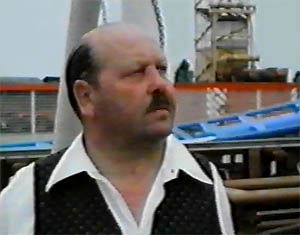
He master-builder inspecting his very first "Looping Star" rollercoaster during test-runs at the factory plant in Münsterhausen. Both images are taken from adocumantation made for television in the late 70s.
Anton Schwarzkopf employed a huge number of other supplier companies, supporting him and his company with parts. At its best time, the Schwarzkopf company had about 200 to 250 employees and was represented outside of Germany by the INTAMIN company. It should be pointed out here that the name INTAMIN is mistakenly used in foreign countries as manufacturer of Schwarzkopf rides.
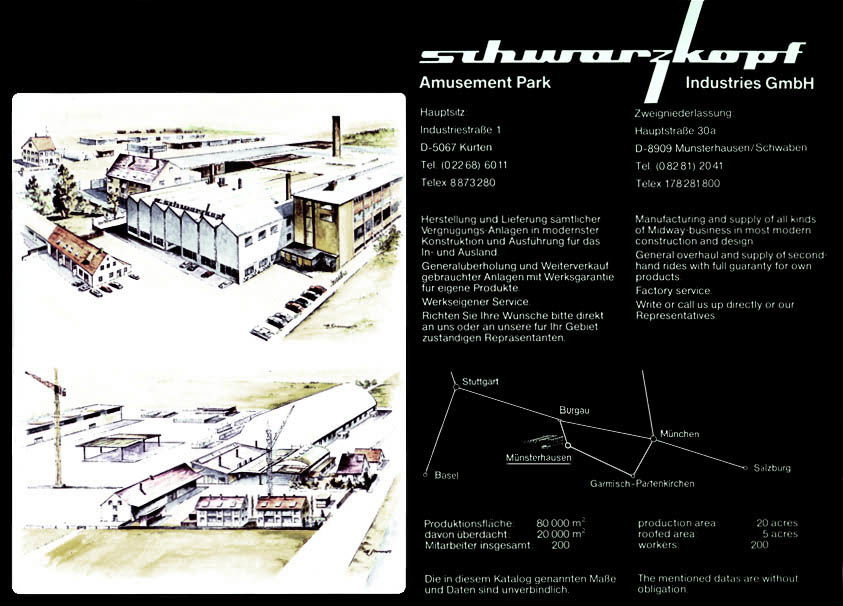
Werner Stengel - this name is an institution. Without him and his trailblazing solutions regarding complicated and complexe calculations, it probably wouldn't be that easy for Anton Schwarzkopf to realize his ideas with such a perfection.The structural engineer Werner Stengel, who worked in the beginning exclusively for Anton Schwarzkopf, started his career within this cooperation and he made a career that others only dream of. From 1964, he and his crew did the statics, designs and dynamic calculations of numerous Schwarzkopf structures.
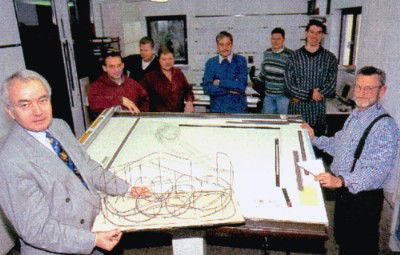
Werner Stengel and The Team
Some pipe bending machines - both, to bend steel pipes in cold as well as in hot condition - were developed in this cooperation too. It can be said that it is easier to bend pipes in hot condition, but cold bended pipes do have an higher strenght. Therefore special pipes, particulary jointless ones which were necessary for the trackpipes, were used. These pipes were made by the german firm Mannesmann.
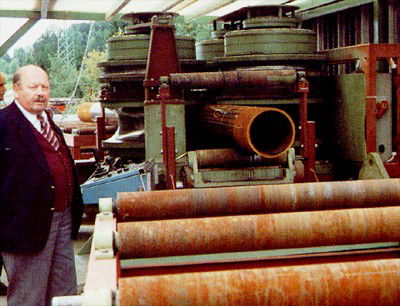
Anton Beside Pipe Bledding Machine
Unfortunately Anton Schwarzkopf has not had a lucky hand being a businessman. The first bankruptcy in late 1983 came completely out of the blue. During this bankruptcy (according to himself) it happened that the company was ruined by the liquidator and "smart alecks". That is why the "Flugbahn" (Flying Coaster) - probably the first working "suspended coaster" ever - for Bush Gardens, USA was not built in Münsterhausen.
Unhappy events that led to bankruptcy:
- A cancellation of a large order/contract from Venezuela.
- Three coasters of the "Münchner Bahn" type were ordered, but only one has been produced.
- Death of the director of the credit-giving bank.
Too much overtime work and untaken holiday of the employees - therefore no short-time work was allowed.
While the four loop coaster "Thriller", for german showman Oscar Bruch, was being produced, the second and final bankruptcy occured. Therefore the coaster was only partly produced at the production plant in Münsterhausen. It was completed by the firm BHS (a bavarian steel and mining company) of Peißenberg, which already supported Anton Schwarzkopf with steel components in the past and so quasi becomming a direct follow-up of his company.
The swabian autodidact did not give up and opened up a small construction office. With a few employees he developed units and components for companies like BHS, ZIERER or MAURER SÖHNE.
As for roller coasters, these are the following:
- "Lisebergbanan" (ZIERER / BHS)Liseberg Park, Göteborg, Schweden
- "Bavarian Mountain Railroad" (ZIERER / BHS)Portopialand, Kobe, Japan
- "Jetline" (ZIERER / BHS)Gröna Lund Park, Stockholm, Schweden
- "Olympia Looping" (BHS)Schaustellerfirma Barth, Deutschland
- "Andalusia Railroad" (BHS)Portopialand, Kure, Japan
- "Venus" (Maurer Söhne)Space World, Yahata, Japan
- "Jetline" ( ZIERER / BHS)Gröna Lund park, Stockholm, Sweden
- "Lisebergbanan" (ZIERER / BHS)Liseberg park, Gothenburg, Sweden
- "Bavarian Mountain Railroad" (ZIERER / BHS) Portopialand, Kobe, Japan
- "Olympia Looping" (BHS)german showman company Barth
- "Andalusia Railroad" (BHS)Portopialand, Kure, Japan
- "Venus" (Maurer Söhne)Space World, Yahata, Japan

1990 at the BHS plant:
Herbert Zoch,Yvonne Green-Vial,Anton Schwarzkopf,Hubert Boch,Wendelin Stückl
(from left to right)
In the background you cansee prefabricated partsof the "Andalusia Railroad"made for Portopialand inKure, Japan.
Lots of the timeless Schwarzkopf machines are well-tried and still in operation today - worldwide. On the used rides market his creations are highly recommended, too. Customers know why!
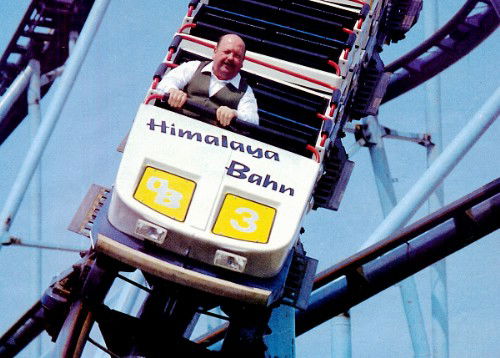
In the year 1995 Anton Schwarzkopf retired - but assisted with his sharp brain and huge know how.
He was awarded with a special award by the "Union of German Manufacturers of Amusement Facilities" at the Interschau trade-fair, which was held in München in 1996.
The production plant in Münsterhausen was purchased by the firm Stein which partly consisted of former Schwarzkopf employees. Stein did some alterations on existing rides and they finished work on a incomplete "Monster III".
They also started construction of an huge, enclosed mixture of rollercoaster and darkride for the german showmen company Renoldi. However, work on Renoldis coaster "Magic Mountain" was completed by the showmen company itself, because the Stein company went into financial problems during its construction.
Hubert Gerstlauer, a former senior manager of the Anton Schwarzkopf company, founded his own company in 1981. For the above mentioned rollerc oasters, that came out of the cooperation between Zierer, BHS and Anton Schwarzkopf, the Gerstlauer Elektro GmbH designed and installed the electrical and pneumatical systems. In 1992, Mr. Gerstlauer purchased the former Schwarzkopf production facility, also gaining some of the most experienced personnel in the industry. From then Gerstlauer had the best base to build amusement rides. But this is a different story.
Anton Schwarzkopf, suffered from parkinsons disease for some years, passed away on July 30th, 2001.
Without him, the amusement industry surely wouldn't be what it is today!
